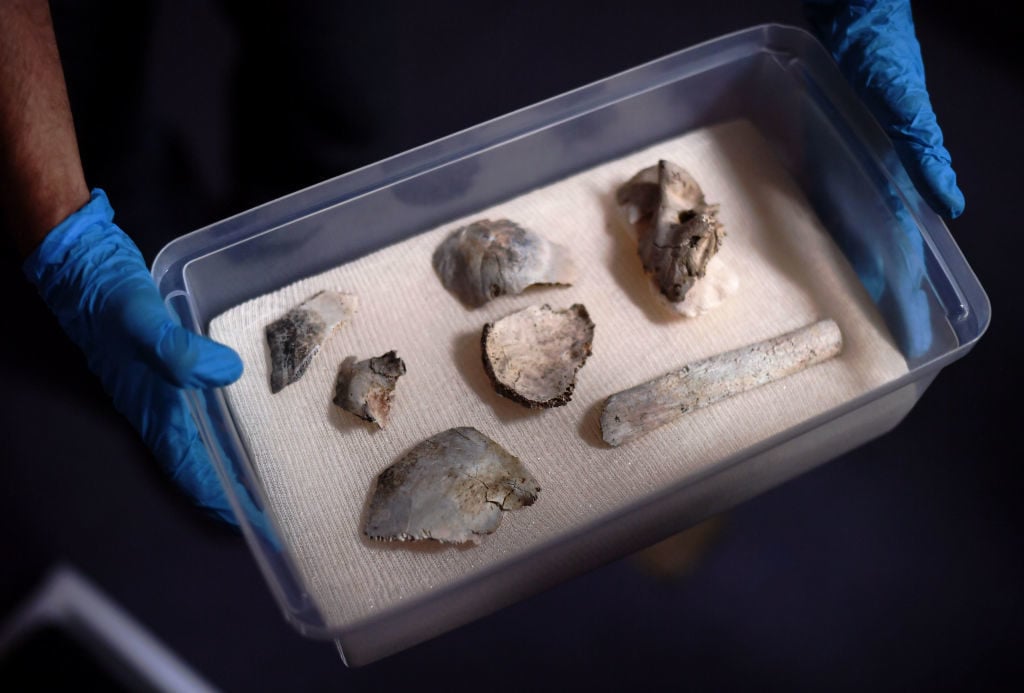Art World
With the Jewel of Its Collection Recovered, Brazil’s National Museum Can Begin to Rebuild ‘From the Ashes’
The prized remains of "Luiza," the oldest human fossil in the Americas, are now a beacon of hope for the fire-ravaged institution.

The prized remains of "Luiza," the oldest human fossil in the Americas, are now a beacon of hope for the fire-ravaged institution.

Naomi Rea

All is not lost for Brazil’s National Museum. Officials at the devastated institution have announced that they recovered pieces of “Luzia,” the museum’s oldest human fossil and one of the most celebrated hallmarks of its collection, in the rubble of the building that was obliterated by fire last month.
The 12,000-year-old remains of a human female were thought to have been incinerated in the blaze, but on October 19 the museum dramatically tweeted about their recovery, saying, “Today we present the skull of Luzia, rescued from inside the building of the National Museum.”
Hoje apresentamos o crânio de Luzia, resgatado de dentro do prédio do Museu Nacional. #museunacionalvive #museunacional #luzia #ciencia #arqueologia #historia #cultura #patrimoniohttps://t.co/AgUsjGKkaO pic.twitter.com/mPMdINveCy
— Museu Nacional/UFRJ (@MuseuNacional) October 20, 2018
Excavated by the French archaeologist Annette Laming-Emperaire from a cave in Brazil in 1975, the bones of a woman dating to the Upper Paleolithic period are the oldest human remains found in the Americas. The skeleton was nicknamed Luzia after the oldest-ever human fossil discovered in Ethiopia the previous year. (That 3.2 million-year-old fossil was called Lucy after the Beatles hit “Lucy in the Sky With Diamonds.”)
Although the fossil was broken into fragments, around 80 percent of Luzia has been found, the director of the Brazilian museum, Alexander Kellner, announced on Friday. Museum staff are confident that the remaining pieces will turn up and that the skull can be reassembled. “They’ve suffered alterations, damage, but we’re very optimistic at the find and all it represents,” the archaeologist Claudia Rodrigues told the AFP. The pieces of skull had been stored in a metal box that helped them resist the damage of the fire.
The recovery is the first positive news to come from the blaze that ripped through the 200-year-old museum on September 2, likely laying waste to up to 90 percent of its collection of over 20 million artifacts. The cause of the fire is still unknown.

What remains of Rio de Janeiro’s treasured National Museum. Photo by Mauro Pimentel/AFP/Getty Images.
The museum is the oldest scientific institution in Brazil, with significant natural history and anthropology collections. Other artifacts feared lost include most of the museum’s 1,800 pieces of pre-Columbian art, dinosaur bones, and examples of mummified remains. Also destroyed were some 500,000 books, documents, and archives from its Scientific Library.
The blaze has set in motion a debate about the Brazilian government’s sparse funding for the important institution, with prominent curators and the public calling out the government’s “negligence” and criticizing its disproportionate support for the 2016 Olympics and 2014 FIFA World Cup.
Brazilian President Michel Temer called the fire’s destruction an “incalculable loss for Brazil” last month. The city’s mayor, Marcelo Crivella, wrote on Instagram, “It is a national duty to rebuild [the Imperial Palace] from the ashes.” The recovery of the museum’s most prized possession offers a beacon of hope from amid the wreckage.